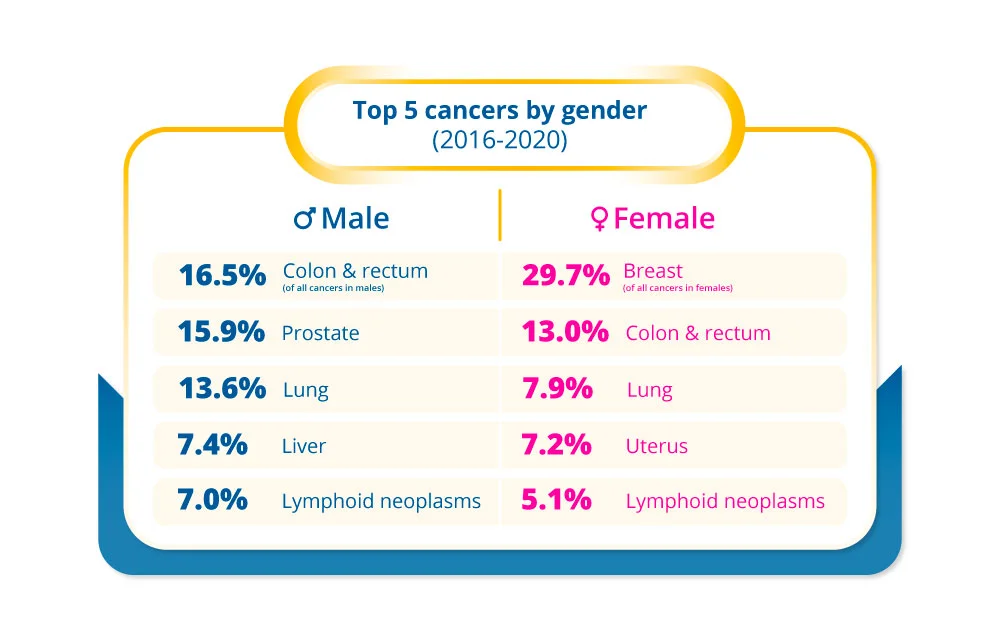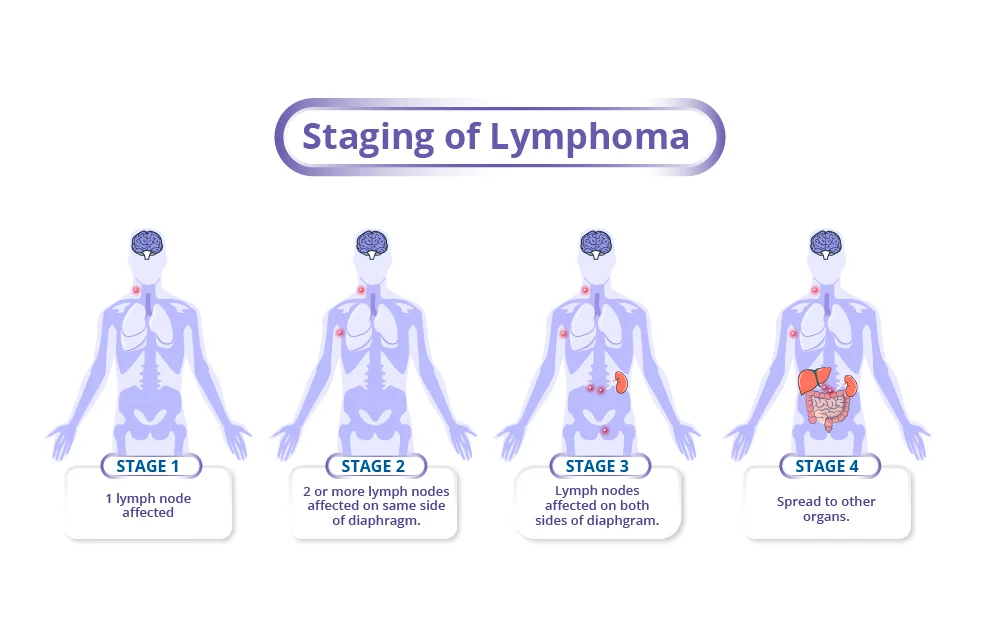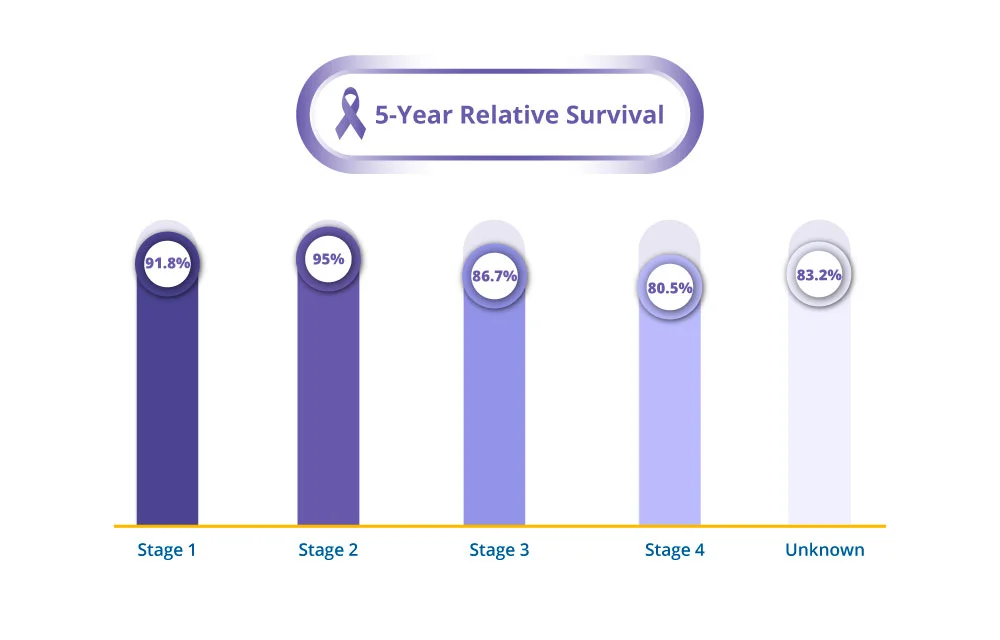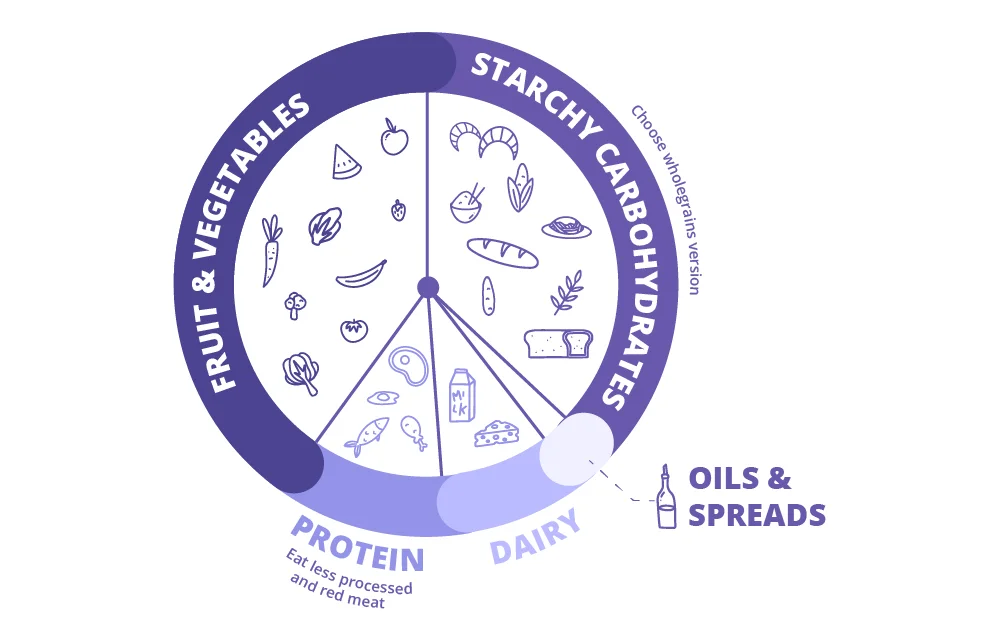Hodgkin Lymphoma
Overview
What is Lymphoma?

Lymphoma is a type of blood cancer involving the lymphatic system, which is part of the body’s germ-fighting immune system. In lymphoma, white blood cells called lymphocytes grow out of control, causing swollen lymph nodes and growths throughout the body1.
Types of Lymphoma
The two main types of lymphoma are Hodgkin lymphoma (HL) and Non-Hodgkin lymphoma (NHL). The primary difference in Hodgkin lymphoma versus non-Hodgkin lymphoma is the presence of a particular cell known as Reed-Sternberg cell, seen under microscope in Hodgkin Lymphoma.
Hodgkin Lymphoma can be further divided into these main subtypes:
- Classical Hodgkin lymphoma - makes up 95% of Hodgkin lymphoma2. It has 4 subtypes: nodular sclerosing, mixed cellularity, lymphocyte rich and lymphocyte depleted.
- Nodular lymphocyte-predominant Hodgkin lymphoma.
Different types of lymphoma have different patterns of growth and spread. Thus, they may be treated differently. The rest of the content below refers to classical Hodgkin lymphoma.
How Common is Hodgkin Lymphoma?

Lymphoma as a group, is the fifth most common cancer seen in Singapore3. It makes up 7% of all male cancers and 5.1% of all female cancers3. Hodgkin Lymphoma makes up approximately 10% of lymphoma cases4.
Hodgkin Lymphoma is more commonly diagnosed in two particular age groups4.
- People between 15 and 40 years old
- People aged 55 years and above
Causes & Symptoms
What causes Hodgkin Lymphoma?
DNA changes in certain lymphocytes (a type of white blood cell) can lead to the development of Reed-Sternberg cells. Scientists have found many gene changes in these cancer cells that enable them to grow and divide uncontrollably or live longer than they should. These cells also release special substances called cytokines that attract other healthy cells to protect them and help them grow further. Crowding of the cells causes the lymph node to swell (enlarge).5
Hodgkin Lymphoma Risk Factors
The reason why some people develop lymphoma and others do not is not clear. However, several factors are known to be associated with the development of lymphoma6:
Epstein Barr virus (EBV) infection
EBV causes infectious mononucleosis (glandular fever) and an increased risk of Hodgkin lymphoma.Immunosuppression
People who have a weakened immune system due to HIV infection, autoimmune diseases or medicines to suppress their immune system after an organ transplant, are at higher risk of getting Hodgkin lymphoma.Family history
Those who have a first-degree relative (parent or sibling) diagnosed with Hodgkin lymphoma are more likely to develop the disease.Sex
Hodgkin lymphoma occurs more often in males than females, particularly in children.
What are the Signs and Symptoms of Hodgkin Lymphoma?
While Hodgkin lymphoma can present with a large variety of symptoms, the common symptoms are1:
- Painless, swollen lymph nodes (glands) that can be felt in the neck, underarm, and groin regions
- Prolonged and recurrent fevers without an infection
- Unexplained weight loss
- Drenching night sweats
- Loss of appetite
- Persistent fatigue
- Severe itching
- Pain in the swollen lymph node after drinking alcohol
The symptoms for non-Hodgkin Lymphoma are also similar to these. Having these symptoms does not mean that someone has lymphoma. In fact, most times these symptoms are not due to cancer. However, anyone with such symptoms should see a doctor to be diagnosed appropriately and treated if needed.
Diagnosis & Assessment
Diagnosis of Hodgkin Lymphoma
The following tests and procedures may be performed to diagnose Hodgkin lymphoma7:
Physical exam
Your doctor will ask about your personal and family medical history and perform a physical examination for masses in your abdomen.Blood tests
You might have some blood tests to look for infection and to assess your general health.Lymph node biopsy
A biopsy of the affected lymph node(s) is essential for the diagnosis of lymphoma. This can be in the form of an incisional biopsy (removal of a small piece of lymph node tissue) or excisional biopsy (removal of an entire lymph node). The biopsy tissue obtained is subjected to special stains that allow accurate classification of the lymphoma type.
Fine needle aspiration (where a needle is inserted into the affected lymph node to draw cells out for examination) is a less invasive form of biopsy but should not be used for diagnosing lymphoma as it might not obtain enough tissue for an accurate diagnosis.
If abnormalities (such as polyps) are found, a biopsy may be required. Often, the abnormal tissue can be removed during colonoscopy or sigmoidoscopy. A pathologist then checks the tissue for cancer cells using a microscope.
How is Hodgkin Lymphoma Assessed?
Once the diagnosis of Hodgkin Lymphoma is confirmed, a staging assessment is carried out to determine the stage (extent) of the disease. Staging, usually with CT scans or PET-CT scans, is done to find out whether the cancer has spread, and if so, to what parts of the body.
Depending on the scenario, further tests like bone marrow aspiration (a small amount of liquid bone marrow is sucked out through a needle) and biopsy (a small piece of bone marrow is removed with a needle) may be carried out to see if the lymphoma is in the bone marrow.
There are 4 stages - Stage I to IV as well as an A or a B category. The various stages are as follows8:
Stage 1
One lymph node area is affected, either above or below your diaphragm.Stage 2
Two or more lymph node areas are affected on the same side of your diaphragm.Stage 3
At least one lymph node area above and at least one lymph node area below your diaphragm are affected.Stage 4
Lymphoma is in multiple lymph nodes and has spread to other parts of your body (e.g., bones, lungs, liver).Category A
Absence of recurrent fevers, night sweats or weight loss.Category B
Presence of recurrent fevers, night sweats or weight loss.

Knowing the stage is useful in guiding treatment plans and likely outcome for the patient.
Treatment of Hodgkin Lymphoma
Hodgkin Lymphoma Treatment Options
Treatment choice is dependent on the subtype of lymphoma, stage, various prognostic (favourable or unfavourable) features of the lymphoma and the patient’s overall health and personal preferences. Treatment may involve any of the following modalities, and are often used in combination9,10.
Chemotherapy
Chemotherapy drugs, also known as cytotoxics, represent the main treatment for someone with newly diagnosed Hodgkin Lymphoma. In general, these drugs kill cells that rapidly divide or grow.
Thus, cytotoxics are highly effective for killing cancer cells but will also damage normal cells of the body which divide rapidly, like the hair follicles and normal blood-forming cells in the bone marrow, leading to hair loss and temporary drop in blood cells (red blood cells, white blood cells, platelets).Immunotherapy
Immunotherapy is treatment that uses the patient’s own immune system, or medications made from components of the immune system, to fight the disease. There are many forms of immunotherapy.
In the case of Hodgkin lymphoma, the main ones are monoclonal antibodies that target a specific protein on the Hodgkin lymphoma cancer cell, and injections known as immune checkpoint inhibitors. These treatments are highly effective in killing Hodgkin lymphoma cells but are usually used as second-line treatment.Radiation therapy (or radiotherapy)
Radiation therapy uses high-energy rays to kill Hodgkin Lymphoma cells. It can shrink tumours and help to control pain. Radiation is sometimes used as first-line therapy in patients who have very large lymph node masses at presentation.Stem cell (or bone marrow) transplantation
A person with recurrent or relapsed Hodgkin lymphoma may be treated with stem cell transplantation, usually as second-line treatment. A transplant of blood-forming stem cell allows a person to receive high doses of chemotherapy, radiation therapy, or both.
The high doses destroy both lymphoma cells and healthy blood cells in the bone marrow. Following this, the patient receives healthy blood-forming stem cells through a flexible tube placed in a large vein in the neck or chest area. New blood cells develop from the transplanted stem cells.
The stem cells may come from the patient (known as autologous stem cell transplantation) or from a healthy, matched donor (known as allogenic stem cell transplantation).
Hodgkin Lymphoma Survival Rate

The outcome for Hodgkin lymphoma has improved significantly over the past decades, due to early cancer diagnosis and major advances in treatment11. More people survive Hodgkin lymphoma than any other cancers2. The 5-year relative survival rate is greater than 80% even when it is diagnosed at Stage IV14. Almost 90% of patients with classical Hodgkin lymphoma go into remission (no sign of lymphoma left in the body) after first-line treatment8.
Some factors that may impact your prognosis (likely outcome) include8.
- Your age and overall health at time of diagnosis
- How your body responds to treatment
- What, if any, genetic mutations your cancer has
- The subtype of Hodgkin lymphoma you have
It is best to discuss your prognosis with your treating specialist as they would be able to give you advice that is specific to your situation based on the information that they have about your cancer.
Prevention & Screening
Hodgkin Lymphoma Screening
Screening refers to looking for cancer before a person has any symptoms. The aim is to detect cancers early so that it can be treated at an early stage. There is currently no recommended screening tests for Hodgkin lymphoma. This is because no screening test has been shown to lower the risk of dying from this cancer12.
Hodgkin Lymphoma Prevention
Few of the known risk factors for Hodgkin lymphoma can be changed, so it is not possible to prevent most cases of the disease at this time.
Frequently Asked Questions (FAQ)
Hodgkin Lymphoma is a fast growing (aggressive) lymphoma. However, it usually responds very well to standard treatment with chemotherapy8. Non-Hodgkin Lymphoma can be fast-growing (aggressive) or slow-growing (indolent) and may or may not need immediate treatment.
The good news is that unlike other cancers, many late stage or advanced lymphomas can be cured13. However, some may be harder to treat and require multiple types of treatment, whilst some slow-growing lymphomas may never be cured, but may not shorten your life either13.
Hodgkin lymphoma has a higher overall 5-year survival rate of around 89%14 compared to non-Hodgkin lymphoma at 74%15. This could be because Hodgkin lymphoma tends to be diagnosed at earlier stages whereas non-Hodgkin lymphoma is more likely to be diagnosed when it is already advanced16.
Hodgkin lymphoma is highly curable. It has the best survival outcome out of all cancers2. Almost 9 in 10 people with classical Hodgkin lymphoma respond well and go into remission after first-line treatment8. Remission means that there is no sign of lymphoma left in your body. Unlike other types of cancer, you can still go into remission or be cured from advanced stage (3 or 4) disease8.
The overall 5-year survival for Hodgkin lymphoma is around 89%14. However, survival rates are estimates based on a large number of people who have a certain cancer. They cannot predict what will happen in a particular individual’s case. Survival rates are grouped based on stage (how far the cancer has spread), but other factors such as your age and overall health and how well the lymphoma responds to treatment can also affect your prognosis (outlook)17.

There is no specific diet recommendation for Hodgkin lymphoma. Consuming a sensible, well-balanced diet with plenty of fruit and vegetables, healthy sources of protein, wholegrains, healthy fats, dairy and enough fluids may help your body to18:
- Cope with treatment side effects
- Handle the best treatment doses
- Recover and heal faster
- Fight off infections
- Feel stronger, healthier and have more energy
There are some alternative diets that claim to cure cancer. However there has been no scientific evidence to support any of these claims to date19.
References
- Mayo Clinic. Hodgkin’s Lymphoma (Hodgkin’s Disease) Symptoms and Causes. Accessed at https://www.mayoclinic.org/diseases-conditions/hodgkins-lymphoma/symptoms-causes/syc-20352646 on 24 July 2023.
- National Comprehensive Cancer Network. NCCN Guidelines for Patients 2023: Hodgkin Lymphoma. Pennsylvania, National Comprehensive Cancer Network; 2023.
- National Registry of Diseases Office. Singapore Cancer Registry Annual Report Infographic 2020. Singapore, National Registry of Diseases Office; 2022.
- HealthXchange.sg. Lymphoma Cancer: Hodgkin and Non-Hodgkin Lymphoma. Accessed at https://www.healthxchange.sg/cancer/lymphoma/lymphoma-cancer-hodgkin-non-hodgkin-lymphoma on 24 July 2023.
- American Cancer Society. What Causes Hodgkin Lymphoma. Accessed at https://www.cancer.org/cancer/types/hodgkin-lymphoma/causes-risks-prevention/what-causes.html on 24 July 2023.
- American Cancer Society. Hodgkin Lymphoma Risk Factors. Accessed at https://www.cancer.org/cancer/types/hodgkin-lymphoma/causes-risks-prevention/risk-factors.html on 24 July 2023.
- American Cancer Society. Tests for Hodgkin Lymphoma. Accessed at https://www.cancer.org/cancer/types/hodgkin-lymphoma/detection-diagnosis-staging/how-diagnosed.html on 24 July 2023.
- Lymphoma Australia. Hodgkin Lymphoma. Accessed at https://www.lymphoma.org.au/types-of-lymphoma/hodgkin-lymphoma/ on 24 July 2023.
- Mayo Clinic. Hodgkin’s Lymphoma (Hodgkin’s Disease) Diagnosis and Treatment. Accessed at https://www.mayoclinic.org/diseases-conditions/hodgkins-lymphoma/diagnosis-treatment/drc-20352650 on 24 July 2023.
- Gleneagles Hospital Singapore. Lymphoma Diagnosis and Treatment. Accessed at https://www.gleneagles.com.sg/conditions-diseases/lymphoma/diagnosis-treatment on 24 July 2023.
- Huang J et al. Incidence, Mortality, Risk Factors, and Trends for Hodgkin Lymphoma: A Global Data Analysis. Journal of Hematology & Oncology. 2022; 15:57; 1-11.
- American Cancer Society. Can Hodgkin Lymphoma be Found Early? Accessed at https://www.cancer.org/cancer/types/hodgkin-lymphoma/detection-diagnosis-staging/detection.html on 24 July 2023.
- Lymphoma Australia. Non-Hodgkin Lymphoma. Accessed at https://www.lymphoma.org.au/types-of-lymphoma/non-hodgkin-lymphoma/ on 24 July 2023.
- Surveillance, Epidemiology and End Results Program, National Cancer Institute. Cancer Stat Facts: Hodgkin Lymphoma. Accessed at https://seer.cancer.gov/statfacts/html/hodg.html on 24 July 2023.
- Surveillance, Epidemiology and End Results Program, National Cancer Institute. Cancer Stat Facts: Non-Hodgkin Lymphoma. Accessed at https://seer.cancer.gov/statfacts/html/nhl.html on 24 July 2023.
- National Foundation for Cancer Research. Hodgkin’s & Non-Hodgkin’s Lymphoma: What’s the Difference? Accessed at https://www.nfcr.org/blog/hodgkins-vs-non-hodgkins-lymphoma/ on 24 July 2023.
- American Cancer Society. Survival Rates for Hodgkin Lymphoma. Accessed at
- https://www.cancer.org/cancer/types/hodgkin-lymphoma/detection-diagnosis-staging/survival-rates.html on 24 July 2023.
- Cancer Research UK. Why Diet Is Important. Accessed at https://www.cancerresearchuk.org/about-cancer/coping/physically/diet-problems/about/why-diet-is-important on 24 July 2023.
- Cancer Research UK. Alternative Cancer Diets. Accessed at https://www.cancerresearchuk.org/about-cancer/coping/physically/diet-problems/managing/alternative-cancer-diets on 24 July 2023.
